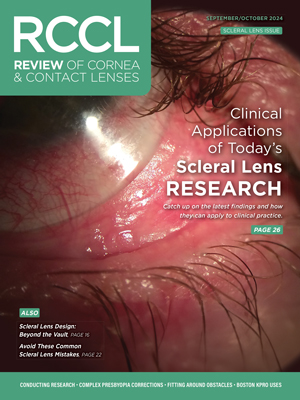 Recent publications have alerted practitioners to the importance of discussing the proper care of contact lens storage cases with every patient on a consistent basis. Unfortunately, there is considerable discrepancy in the recommendations of various agencies, industry, experts and practitioners.1,2 These conflicting recommendations are found in reviews of practice patterns about caring for cases. The uncertainty is primarily about drying positions, rinsing and rubbing of lens cases, and recommendations for lens storage case replacement.2-4 But, it’s critically important to come to a consensus regarding the best method of care for lens storage cases.
Recent publications have alerted practitioners to the importance of discussing the proper care of contact lens storage cases with every patient on a consistent basis. Unfortunately, there is considerable discrepancy in the recommendations of various agencies, industry, experts and practitioners.1,2 These conflicting recommendations are found in reviews of practice patterns about caring for cases. The uncertainty is primarily about drying positions, rinsing and rubbing of lens cases, and recommendations for lens storage case replacement.2-4 But, it’s critically important to come to a consensus regarding the best method of care for lens storage cases.
What Lurks in the Case
Lens cases are a potential milieu for biofilm formation and microbial contamination, which enables microbes to resist antimicrobial agents. Also, growth in these biofilms tend to make microbes generally more virulent (see “Biofilms: A Look Inside the Case”).1 Over the years, various strategies have been employed to minimize and attempt to eliminate biofilm formation. In designing cases to resist biofilm formation by using silver or sodium salicylate, it is crucial to be certain that these agents do not further enhance microbial virulence.1,4 The antimicrobial cases may be overwhelmed with microorganisms and perform poorly when there is a heavy inoculum.
Another reason that lens case hygiene is critical is because storage cases have the highest rates and levels of contamination of all lens care accessories and accoutrement. In fact, over half of all cases are contaminated with an array of pathogens.2 The most frequently recovered organisms are coagulase negative Staphylococci, Bacillus spp. and fungi.3 There are definite differences in the frequency and type of organisms found depending on the case location examined. Different bugs hang out in different locations of the lens case.2 Manufacturers must keep this in mind when designing next-generation lens cases, and perhaps better lens case design and promotion of more thorough hygiene will reduce the potential for contamination in the future.2-4
How to Keep Lens Cases Clean
So, what are the appropriate patient recommendations regarding lens storage case care? For now, patients should be instructed to clean, rinse (with solution—not tap water) and dry cases after every use, removing all previously used solution.2,4 The FDA advises lens wearers to flip the lens case over to remove excess solution from the case and to replace the case every three to six months. Some practitioners and industry representatives advocate monthly replacement of lens cases, even though there are no published studies to show any major advantages over the initial FDA recommendation.4
The bathroom environment may predispose storage cases to air-borne sources of contamination, so patients should store their lenses and cases away from toilet areas.4 Finally, never allow patients to re-use solution. Every patient who re-uses solution is at significantly higher risk for case contamination.4
Stay Tuned
Although many groups, organizations and individuals have suggested guidelines of care for contact lenses and accoutrements, additional research is needed in order to reach a consensus among practitioners as to the optimum recommendations for lens storage case care. These recommendations would be similar to the cleaning instructions for lenses that are included in FDA labeling.2,4 In the meantime, educating patients on frequent lens case replacement along with standard hygiene procedures will likely reduce the chance of contamination.
1. Fleiszig SMJ, Evans DJ. Pathogenesis of contact lens-associated microbial keratitis. Optom Vis Sci. 2010 Feb;87(4):1-8.
2. Wu YT, Hua Z, Harmis NY,et al. Profile and frequency of microbial contamination of contact lens cases. Optom Vis Sci. 2010 Jan;87(3): 152-8.
3. Wu YT, Carndt N, Wilcox M, Stapleton F. Contact lens and lens storage case cleaning instructions: whose advice should we follow? Eye Contact Lens. 2010 Mar;36(2):68-72.
4. Hall BJ, Jones L. Contact lens cases: the missing link in contact lens safety? Eye Contact Lens. 2010 Mar;36(2):101-5.


